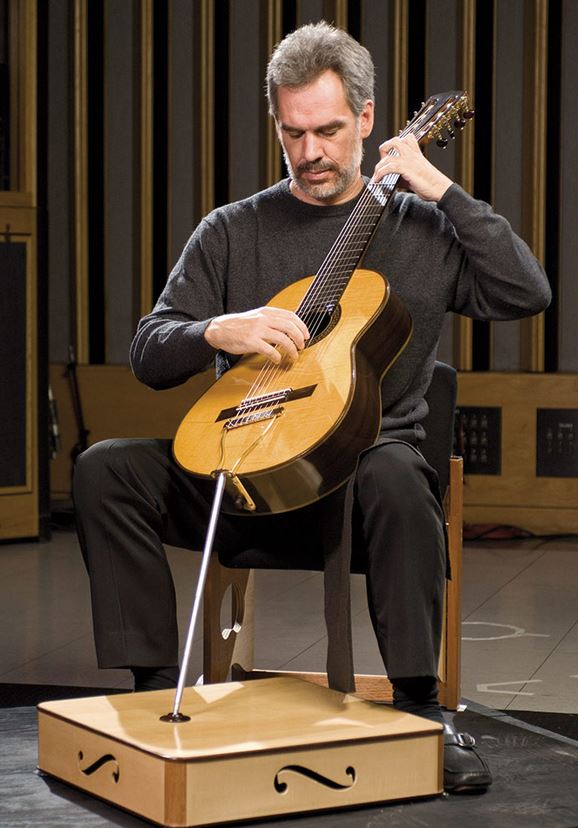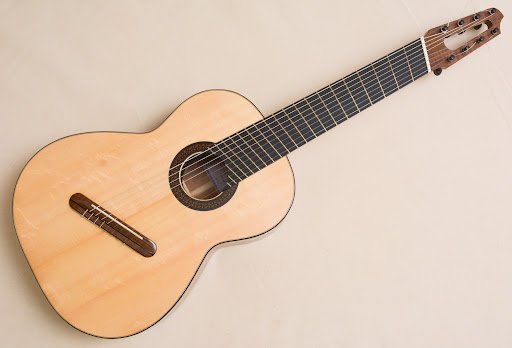I wanted to showcase this musician partly for his virtuosic ability and partly for his unique approach to playing guitar. After having studied classical guitar for 4 or 5 years on my own and academically and then switching my focus to cello, I come across Paul Galbraith. I tried this approach a little and decided if I was ever to continue with classical guitar I would utilize this way of playing due to ergonomics. To me it makes incredible practical sense, in particular with the right hand, to the point of making the traditional classical guitar playing posture seem even archaic, unnatural and cumbersome. With Galbraith’s style, both wrists are straight relative to the guitar, unlike traditionally where both wrists are angled, which allows more natural uninhibited motion for the arms, wrists and especially fingers. I wanted to include more live performances by him in this article but in years past and now there are very few videos of him performing live that I could find.
Paul Galbraith
Born in Edinburgh, Scotland in March 1964, Paul Galbraith is internationally renowned as one of the foremost guitarists of our time. His revolutionary approach to guitar playing has made him an instantly recognizable figure in classical music, but it is ultimately his interpretative breadth which has captivated audiences the world over.
An individual approach to guitar posture was developed early on when, at age 20, following a period of intense investigation into technique, Paul discovered a playing position which allowed equal freedom of movement for both arms. Within three years, this developed into the cellist’s posture he is associated with today.
It was a natural step for Paul to adapt a cello end-pin to his guitar, enabling him to further liberate the guitar’s resonance. Later on, a resonance box, designed to enhance and enrich tone quality – an idea also inspired by cellists’ equipment: their stage platforms – and a collapsible, custom-built low chair, was to complete Paul’s playing set-up.
Paul plays a unique 8-string guitar, which he developed in 1993 together with renowned luthier, David Rubio. As a convenient means of differentiating it from the traditional 8-string guitar, Rubio called it the ʻBrahms Guitarʼ, reflecting Rubio’s enthusiasm for the way this guitar, with its rich sound and wide range, performed in the music of Brahms, through Paul’s transcription and rendition of the Op21a Variations.
On this instrument, Paul has recorded a series of highly acclaimed albums, most famously Bach’s complete Solo-violin Sonatas & Partitas, which was nominated for a Grammy Award in 1998, as well as the complete works of Bach’s lute suites.
Paul began concertizing in his late teens, having come to public attention in Great Britain through a series of televised competition successes. Since then, Paul has performed throughout the European Union, as well as in China, South America, Russia, Norway, Australia, Canada and India. From the early nineties onwards, he has toured regularly throughout the USA.
Paul Galbraith with his “Brahms Guitar” and resonance box with cello like end pin
A Martin Woodhouse 8-string “Brahms guitar,” notice the asymmetrical frets on the fret-board
J.S. Bach: Lute Music BWV 995-998 Playlist
J.S. Bach: Sonatas and Partitas for Solo Violin BWV 1001-1006 Playlist
Haydn: Keyboard Sonatas Nos. 11, 31, 32 and 57 Playlist
Performing – Paul Galbraith | Adagio Sonata K570 – Mozart | Allemande
Performing – Mozart Piano Sonata K280 Adagio
Paul Galbraith Concert Promo – Very short clip of playing
GuitarCoop Interview Series – PAUL GALBRAITH – Part I ( I could not find Part II, even on their website)
 RSS Feed
RSS Feed















 July 21st, 2021
July 21st, 2021  Awake Goy
Awake Goy 

 Posted in
Posted in  Tags:
Tags: 













